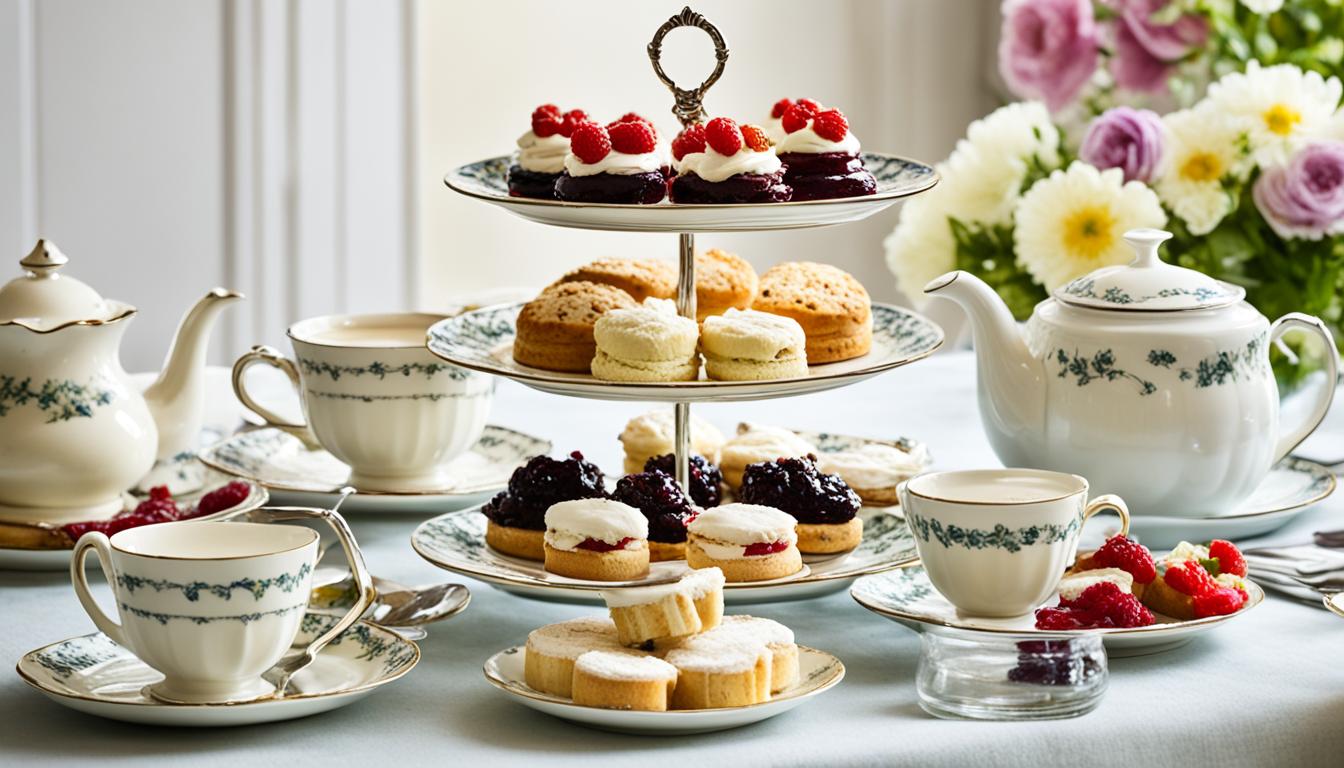Welcome to our guide on the correct order of a traditional British cream tea. As tea lovers and enthusiasts of English traditions, we often find ourselves pondering the age-old question: should the cream or the jam be spread first on a scone? It’s a debate that has divided the nation, with Devonians and Cornish people staunchly defending their respective traditions. But what is the correct order, and does it really matter? Let’s delve into the world of cream teas and uncover the truth behind this delicious controversy.
Whether you call it a scone or a “scohn,” it’s undeniable that this delicacy is the heart and soul of a proper cream tea. Served with clotted cream, jam, and a steaming cup of tea, a cream tea embodies the essence of English tradition and tea time elegance.
But when it comes to the order of cream and jam, opinions vary. Some argue that practicality takes precedence over etiquette, advocating for the cream to be spread first. On the other hand, there are those who assert that jam should be the inaugural layer. So, who is right?
Interestingly, even royalty has weighed in on the matter. According to Queen Elizabeth II, jam should be the first layer, as applying a generous amount of cream directly onto a fragile scone can lead to crumbling and chaos. But does this settle the debate once and for all?
Join us as we explore the origins of cream tea, the arguments from both sides, and the cultural significance of this beloved British treat. We’ll uncover the truth behind this great cream tea debate and shed light on the correct order, while leaving room for personal preference. After all, in the world of cream teas, is there really a wrong choice?
Afternoon Tea Etiquette
Afternoon tea is a classic British tradition that can be enjoyed at luxury hotels or casual cafes and restaurants. It is typically taken between 3 and 5pm, with 4pm being the recommended time.
The dress code varies depending on the venue, with luxury hotels requiring more formal attire. It is best to dress smartly and avoid overly casual or beachwear attire.
When pouring tea, it is important to use a strainer to prevent leaves from getting into the cup. This ensures a smooth and enjoyable tea-drinking experience.
The correct way to hold a teacup is to join the thumb and index finger in the handle and support the handle with the middle finger. This elegant and proper hold allows for ease of handling and prevents accidents or spillages.
Whether to put milk or tea in the cup first is a matter of personal preference. Traditionally, milk was poured into the cup first to prevent the hot tea from cracking delicate porcelain cups. However, others prefer to add milk after the tea is poured to control the strength and color of their tea.
Afternoon tea usually includes sandwiches, scones, and pastries, which should be eaten in a specific order. Start with the sandwiches, which are usually served with crusts removed and cut into bite-sized pieces. Use your fingers to eat them, avoiding any need for utensils.
Next, scones are enjoyed. They should be broken in half with your hands and topped with jam and clotted cream. The debate of cream or jam first on a scone continues, but the tradition in Devon is to spread cream first, followed by jam. In Cornwall, they choose to spread jam first, then cream. It’s up to you to decide which method you prefer!
Pastries, such as cakes and tarts, can be enjoyed with your hands or a fork, depending on their size and level of messiness. Use your judgement to determine the best way to savor each sweet treat.
When using a knife and fork, hold them correctly and cut your food into smaller, manageable pieces. Refrain from using your knife to push food onto your fork; instead, use the fork to scoop up bites of food.
The duration of afternoon tea can vary depending on the venue and occasion. Some experiences may last a couple of hours, allowing guests to leisurely enjoy the assortment of teas, treats, and conversations. Other experiences may be shorter, focusing on a specific tea set or theme.
Overall, afternoon tea is a delightful opportunity to relax, indulge in delicious treats, and enjoy the company of others. So whether you’re a tea connoisseur or new to the world of afternoon tea, be sure to embrace the etiquette and traditions to fully immerse yourself in this quintessentially British experience.
The Great Cream Tea Debate: Jam or Cream First?
The age-old question of whether to spread jam or cream first on a scone has sparked a spirited debate between Devonians and Cornish people. Delving into historical manuscripts, we discover that the original cream tea was served in Devon with cream first, followed by jam. However, Cornwall argues that jam should take precedence to prevent the cream from melting due to the warmth of the scone.
Passionate opinions abound on both sides, with each group staunchly defending their preferred way. The Queen herself follows the Cornish tradition, indulging in her cream tea with jam first. The disagreement has spilled over into the realm of social media, where Cornish people proudly uphold their tradition, often using the hashtag #creamisnotbutter.
Despite efforts from various quarters to settle the matter, there appears to be no definitive answer to the jam or cream first question. Ultimately, assembling a cream tea according to personal preference seems to be the prevailing rule. So whether you’re team jam first or team cream first, the choice is yours to savor the delightful combination of a freshly baked scone with clotted cream and delicious jam.
